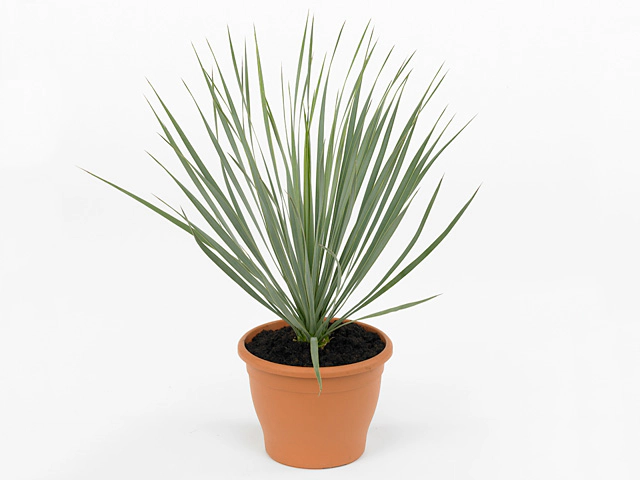Yucca rostrata

| Leaf arrangement | wreath, in a rosette |
| Leaf tip | Pointed/acute |
| Leaf base | Perfoliate |
| Leaf margin | Dentate |
| Winter hardness | Reasonable (USDA-zone 7) |
| Leaf, general shape | Linear |
| Structure (tissues) | Woody |
| Leaf width | 0 - 1 cm |
| Leaf surface | Glaucous |
| Leaf duration | Evergreen |
| Leaf size | 30 - 40 cm |
| Light conditions | Sunny |
| Leaf division | Simple |
| Leaf, main color | Green grey |
| Leaf colour, pattern | Marginate |
| Leaf, secondary color(s) | Yellow |
| Moisture requirements | Dry; Well-drained |
Yucca rostrata, commonly known as Yucca or Palmlilie, is a stunning plant with unique characteristics that make it a popular choice for landscaping and gardening. This article will explore the various aspects of Yucca rostrata, including its leaf arrangement, winter hardiness, structure, and moisture requirements.
One of the distinguishing features of Yucca rostrata is its leaf arrangement, which forms a wreath-like pattern in a rosette shape. The leaves have a pointed or acute tip, adding to the plant's attractive aesthetic. Furthermore, the leaf base is perfoliate, which means it surrounds the stem, giving it a distinctive appearance.
Yucca rostrata has dentate leaf margins, meaning the edges are finely toothed, adding texture to its overall look. The leaf general shape is linear, characterized by long, slender leaves that create an elegant appearance in the landscape. The leaves are woody in structure, providing durability and longevity for the plant.
When it comes to size, Yucca rostrata's leaves are relatively narrow, measuring between 0 and 1 cm in width. The leaves are glaucous, giving them a bluish-grey appearance, which adds to the plant's overall visual appeal. Moreover, Yucca rostrata is an evergreen, meaning its leaves remain green throughout the year, adding color and vitality to the garden even during colder months.
The average leaf size of Yucca rostrata ranges from 30 to 40 cm, making it a substantial plant that can create a focal point in any landscape. This yucca thrives in sunny conditions, requiring ample sunlight to reach its full potential. Therefore, placing it in a well-lit area will ensure its healthy growth and development.
Yucca rostrata's leaf division is simple, with each leaf consisting of a single blade. The main color of the leaves is green-grey, providing a natural and earthy tone to the plant's appearance. Additionally, the leaf pattern is marginate, which means the edges of the leaves are adorned with distinctive markings.
In terms of secondary colors, Yucca rostrata's leaves can display shades of yellow, adding vibrant accents to its overall color palette. When it comes to moisture requirements, Yucca rostrata prefers dry conditions with well-drained soil. This plant is well-adapted to arid environments, making it an excellent choice for xeriscaping or water-conscious gardening.
Another notable characteristic of Yucca rostrata is its reasonable winter hardiness, typically suitable for USDA zone 7. This means the plant can endure colder temperatures and frost, making it a reliable option for gardens in regions with moderately cold climates.
In conclusion, Yucca rostrata is a visually striking plant with numerous appealing features. Its wreath-like leaf arrangement, pointed leaves, perfoliate base, and dentate margins create a unique and attractive aesthetic. The plant's woody structure, narrow glaucous leaves, and evergreen nature contribute to its year-round visual appeal. Yucca rostrata thrives in sunny conditions and requires dry, well-drained soil, making it a great choice for water-wise gardening. With its reasonable winter hardiness and vibrant yellow secondary colors, Yucca rostrata is an excellent addition to any landscape or garden.
Market availability index by month:
| Jan. | Feb. | Mar. | Apr. | May | Jun. | Jul. | Aug. | Sep. | Oct. | Nov. | Dec. |
|---|---|---|---|---|---|---|---|---|---|---|---|
| 1 | 1 | 1 | 1 | 2 | 1 | 4 | 1 | 1 | 1 | 1 | 1 |